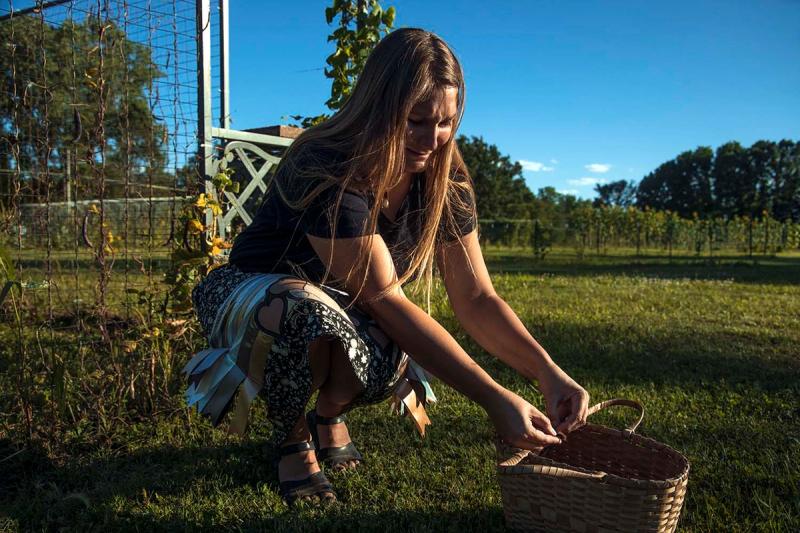Seeds, Reunited


‘Rematriating’ ancestral seed to Indigenous lands
Re· ma· tri· a· tion
the act or process of returning the sacred to the Mother
“The most dangerous place for a seed is in a jar on a shelf,” says Jessika Greendeer, Ho-Chunk seed keeper and farm manager at Dream of Wild Health in Hugo, Minnesota.“The safest place for that seed...is in the care of multiple hands.”
Seeds need to be grown, tended, and shared. In 2017, Rowen White, Seed Savers Exchange board chair and program coordinator for the Indigenous Seed Keepers Network (ISKN), approached Seed Savers Exchange’s (SSE) preservation staff about collaborating on the Seed Rematriation program through the Native American Food Sovereignty Alliance. Donations of Indigenous varieties to the seed collection grew for long-term preservation.

During 2018 and 2019, White assisted preservation staff in selecting varieties to grow at Heritage Farm, SSE’s headquarters outside Decorah, Iowa, and helping return seeds back to the Indigenous communities from which they originated.
The highlight of the first two years was a rematriation ceremony in Taos, New Mexico, for one of those varieties, the ‘Taos Pueblo’ squash.
'Shield,' an Algonquin variety bean
In 2020, SSE collaborated with Jessika Greendeer and two other Indigenous women—Shelley Buffalo, then food sovereignty coordinator with the Meskwaki Nation (Tama, Iowa), and Becky Webster, an enrolled citizen of the Oneida Nation (Oneida, Wisconsin)—via ISKN to rematriate seeds.

Jessika Greendeer, Cale Stelken photo
Across the four partner sites, 27 varieties were grown for rematriation, mostly beans, corn, squash, and tobacco. This collaboration was funded by a grant awarded by the the North Central Region Sustainable Agriculture Research and Education (SARE) program.
Staying apart, fighting derecho
The COVID-19 pandemic delayed in-person field days at partner growing sites, and were changed to virtual get-togethers. Cale Stelken, a videographer from Iowa City, Iowa was able to create a poignant video featuring Jessika, Shelley, and Becky, and their work to bring the seeds home.
It is available on SSE’s YouTube channel, SSEHeritageFarm.
“To be onsite and have the in-person conversations with Jessika and Becky really helped to inform and support what we do here in the Meskwaki Nation,” Shelley says.
Support was crucial when, in August, 2020 a severe derecho storm swept through central Iowa with 80-100 mph winds. The damage was immense on the Meskwaki Nation, but Shelley believes this was the Earth talking.
“In Meskwaki culture, the fallen corn are fallen men who are crying because they will go to waste,” she says of harvesting that corn. “I could not ignore the cries.”
Shelley further notes that the corn grown by one Meskwaki farmer in a traditional four-foot mounded grid stood up after the derecho and continued to grow and flourish, unlike corn that had been growing in rows.

Becky Webster, Cale Stelken photo
Becky uses this same mounded system for the “three sisters” garden of corn, beans, and squash on her 10-acre farm on the Oneida Reservation. Becky says this is an example of polyculture developed by Indigenous ancestors: “The mounds, with buried fish providing fertilizer at the bottom, create the ideal environment for corn, beans, and squash to thrive.”
Sovereign sharing, reuniting
Jessika and Becky declare the twin goals of seed and food sovereignty fuel their work. “Indigenous food sovereignty to us is a way to reconnect to our identity, a way to assert ourselves, a way to reclaim who we are, and a way to let everyone know that we’re still here,” says Becky.
Adds Jessika: “You cannot have food sovereignty without seed sovereignty.”
This past year, Becky formed a bean growing co-op and shared the beans she grew with many community members, while Jessika connected with 10 women who were eager to bring home their seed relatives. “This was the first year I was able to grow one of my ancestral bean seeds, and it felt like welcoming someone home you never met before,” says Jessika. “That feeling can’t be replaced by anything else, and I want to help create that feeling for others by bringing even more seeds home.”
Seed Savers Exchange received another SARE partnership grant to expand this collaboration to eight partners and nine Upper Midwest sites in 2021—an opportunity to learn from Indigenous farmers and friends and serve as a conduit for them to welcome their ancestral seeds home.

Shelley Buffalo, Cale Stelken photo
Says Shelley: “With seeds there is no language barrier. When you grow them out, tend to them, and complete the circle of keeping the new seeds, you are connected through that process to your grandmothers going back thousands of years. That is their universal language.”
This article was originally published in the Heritage Farm Companion, Seed Savers Exchange’s member magazine
Tags:The Farm Babe

Acreage Life is part of the Catalyst Communications Network publication family.















